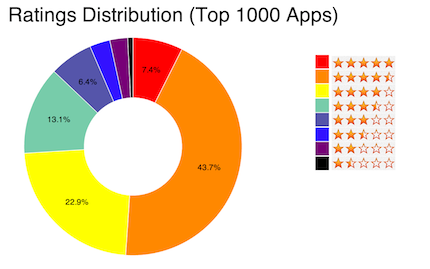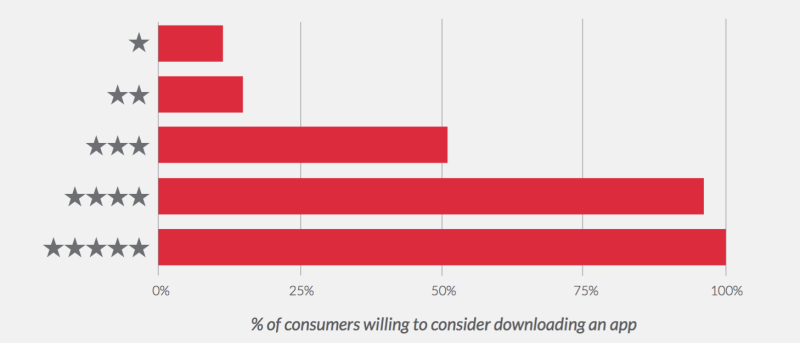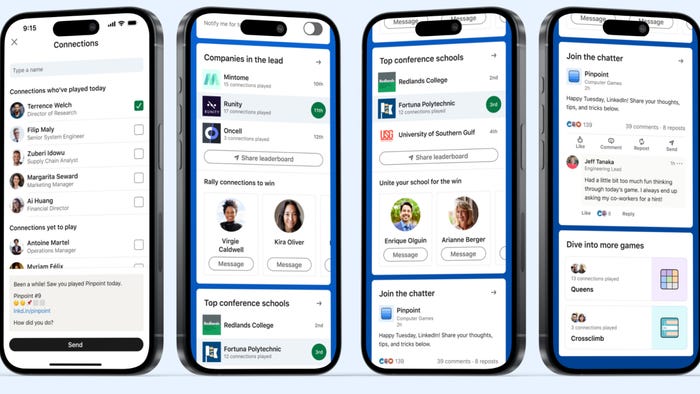How to Improve Your App’s Ranking With Positive Reviews And a Higher Rating: 5 Simple Steps
Just a one app rating can lead to a significant increase in number of installs. A recent survey by Apptentive shows that the number of stars directly impact the number of downloads.

There are over 3 million apps out there and app developers need to use every promotional method possible to stand out from this the rest. Getting positive reviews and ratings will definitely help your app get noticed. Although there is no publicly available official information on ranking algorithms on both Google Play and the Apple App Store, most studies show that ratings and reviews play a vital role in the app ranking process. They work as social proof convincing a potential user that the app is worth downloading. While two thirds of apps in the US App Store don’t have any reviews, positive reviews will definitely increase your app’s discoverability and drive downloads. According to an Apptentive study, 98% of top free apps have at least 4-star ratings.

Source: Appurify
“Star Wars” in app stores
Just a one app rating can lead to a significant increase in number of installs. Arecent survey by Apptentive shows that the number of stars directly impact the number of downloads. Moving from 2-stars to 3-stars rating can enhance app store conversion by 340%. 3 to 4 stars increases downloads by 89%. As much as 60% of survey respondents said that they almost always check an app’s rating before installing it.

Source: Apptentive Consumer Survey (2015)
What comes first: reviews or installs?
Getting good, or any, ratings and reviews for your app could be a real problem. It’s a vicious cycle. You need a good ranking in order to let users notice and choose your app, but you won’t get any reviews until reaching the proper number of installs first.
There was one infamous app that overcame this problem, Flappy bird. In the first version of the game, the “rate” button appeared at the end of the play session and it was placed in the spot where a user would tap to continue the game. This way, the “rate” button had gathered a lot of unintentional taps and the Flappy bird app received good ratings from the start.
Although one should not use the same “dark patterns” in getting users to review an app, it never hurts to utilize an intelligent approach in asking for positive ratings. Though you have to be careful. App users are more likely to live review after a negative experience with the product than they are for some positive practice (however, this is true for any other industry and platform).
Steps toward positive rating
Negative ratings and reviews do not always mean the app is bad. Reviews are biased. How can app developers control ratings and reviews and make them work in their favor?
Use rating prompts wisely
Rating prompts are in-app messages designed to encourage users to rate your app. They are proven to be an effective tool for increasing volume of positive reviews and ratings. Prompts should be utilized carefully. Showing them too much or at the wrong time could annoy users and lead to negative reviews. Don’t use prompts on newly-registered users, let them get their positive experience first. Showing a rating prompt to each customer once is a good practice.
2. Update app frequently
Apps with older versions are more likely to have lower ratings in comparison to apps that are updated often, according to an Alex Walz study. The 100 top apps in both Google Play and Apple App Store are updated more frequently than average apps.
3.Start dialog with your user
You can prevent negative ratings by creating an in-app feedback form for reporting bugs and problems. Let users share their negative impressions to you directly rather than publish them on the app stores. Addressing negative reviews will also help to increase retention rate and improve app reputation.
4. Don’t forget about CPI advertising
It’s hard to achieve a high ranking without a proper amount of organic traffic. Utilizing rewarded installs boost campaign is the fastest and most efficient way to reach app visibility and gain organic downloads. Self-serve platformAppBooster lets app developers reach certain ranking positions in a short amount of time even with a limited budget.
5. Good old ASO
App store optimization strategy is a basic step toward app discoverability. Utilizing ASO is especially important when your competitors have higher ratings. It helps users find your app while browsing app stores and also make paid marketing efforts more efficient. App marketing agency ComboApp can take care of your app’s ASO and create appealing app screenshots, develop an effective set of keywords, and design an app icon that will stand out.
Read more about:
BlogsAbout the Author(s)
You May Also Like








